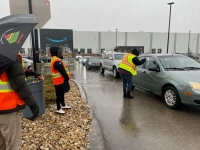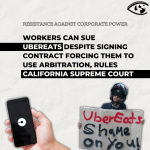Sky High Injury Rates and Union-Busting at Amazon Warehouses in Alberta

Amazon's warehouse in Nisku, Alberta. Photo courtesy Teamsters.
“Signing up to work at Amazon is strangely easy, it really isn’t much of a hiring process. Liam*, a 34-year old worker in the city of Edmonton in the Canadian province of Alberta, told CorpWatch. “You just have to put your name and SIN number [Social Insurance Number] on the internet and you’re hired.”
Liam found the point-and-click hiring process and the ‘benefits from day 1’ offered by the online retail giant appealing. He applied for a job at the Amazon warehouse in Nisku, just south of Edmonton, and was hired shortly thereafter as an ‘order picker operator’ driving machinery to stock shelves, check inventory, pack and ship new orders from customers as they come in.
But after working at the warehouse for several months, he found the intensity and pace of the workload to be too physically demanding.
“This job really beats you up quite a bit… Quickly I wasn’t able to pick up much. My grip became weak, my elbows were in pain. I was taking 400 mg of Advil [a painkiller] every break. I was losing sleep,” he said.
Liam is not alone. Similar stories about the effect that the workload has on employee physical health were shared by other Amazon warehouse workers in Alberta.
Anne,* a single mom signed up for a job at another Amazon warehouse in Balzac, just north of the city of Calgary shortly after moving to the city. She was hired as a warehouse ‘associate’ where she was predominantly tasked with picking items. It was the only job she could find at the time. She says that she received awards for being the fastest and most productive worker. But eventually the job began taking a toll on her body too.
“Within 6 months I got plantar fasciitis in my feet because I am always walking. Plantar fasciitis is very painful. It’s like walking on glass,” Anne told CorpWatch. “I then got tennis elbow within 3 months of starting because of overuse. I am always lifting heavy things. The pain doesn’t go away. I’ve been on a leave now for 3 months and it is finally coming back to normal. The worst was carpal tunnel in both of my wrists.”
Amazon’s High Injury Rates
Amazon employs around 25,000 people in Canada and has some 50 warehouses and logistics centers scattered across the country. The Balzac and Nisku warehouses are the two big ‘fulfilment' centers located in Alberta.
The Balzac warehouse sprawls over 600,000 square feet, equal about the size of eight soccer fields put together. It employs 1,000 full time workers and many more in peak season such as the winter holidays. The Nisku warehouse is almost twice as big – at one million square feet. It opened in 2020 and has 600 full time employees plus seasonal workers.
Right before Amazon opened its Nisku warehouse, Vibhore Arora, Amazon’s director of regional operations in Canada, told CTV News Edmonton: “Amazon employees have a long-term future with us.”
But Amazon workers have one of the highest rates of injuries in the wholesaling industry in Canada, according to data collected by Alberta’s Workers’ Compensation Board. (The few companies that suffer higher rates of injuries typically use more dangerous equipment– such as the cattle slaughterhouses of Cargill in High River and Harmony Beef in Rocky View.)
In 2020, the Amazon warehouse in Balzac employed the equivalent of 3,635 full time employees. (Employment numbers are typically counted in full time equivalents because many workers are employed on a part time or seasonal basis.) These workers suffered a disabling injury rate of 19.42 per 100 workers per year. That number stands in sharp contrast with a disabling injury rate of 6.19 per 100 workers per year in 2020 recorded by Costco warehouse in Nepean, Ontario. (The Nepean site was the only one recorded by the Alberta’s Workers’ Compensation Board). And it is almost seven times higher than the average rate of 2.9 per 100 workers per year in 2020 across all industries in Alberta.
“Everybody I know and I know a lot of people [at Amazon]. I don’t know anybody that hasn’t worked there without an injury,” Anne told CorpWatch.
Data published by the Workplace Safety and Insurance Board in the province of Ontario also shows that the injury rates at Amazon more than doubled from 2012 to 2022. According to the data on injuries over the resulting in lost work time over the ten year period, 62 percent were sprains and strains; 35 percent were caused by boxes, containers, barrels and packages; and 22 percent were injuries to the lower back.
All told, in 2022 Amazon Canada was ordered to pay out almost $5 million for more than 1,300 workplace injuries.
Amazon did not directly contradict company injury rates in Canada but referred to its global record. "The safety and health of our employees is, and always has been, our top priority, and any claim to the contrary is false," Ryma Boussoufa, Amazon Canada spokesperson, wrote in an email to CorpWatch. "The truth is we’re making marked progress, including a nearly 24% reduction in our recordable injury rates worldwide since 2019.”
Boussoufa also pushed back at the claims by the workers. "It’s not surprising that self-interested groups would try to spin their own misleading narratives," she wrote in her email to CorpWatch. “There will always be more to do, and we’ll never stop working until we’re the safest company in our respective industries."
Numbers from the U.S. back up Amazon’s claims to a certain extent but they also show that Amazon still has one of the worst records in the business. In November 2019, the Center for Investigative Reporting showed that the injury rate at Amazon U.S. averaged 9.6 serious injuries per 100 full-time workers in 2018, approximately 2.4 times the industry average of 4 injuries per 100 full-time workers.
By 2022, Amazon’s reports of serious injuries had dropped to 6.8 for every 100 but the U.S. industry average had also dropped to 3.3 serious injuries per 100 workers, according to data gathered by the Strategic Organizing Center.
However, these numbers are not considered totally accurate – the U.S. Department of Labor’s Occupational Safety and Health Administration has cited multiple instances of Amazon’s undercounting injuries.
COVID-19
Stories of employees/workers having to work during their breaks and urinate in bottles in order to meet their quotas or risk being fired are common at Amazon’s facilities around the world. This was exacerbated by the unprecedented demand caused by a peak in online shopping during the Covid-19 pandemic.
As the pandemic unfolded, demand rose at Amazon and the company hired more workers to work in the warehouses – which caused the number of Covid-19 cases to rise too. Workers expressed concerns about the lack of protective equipment and the lack of information on how to work in crowded spaces.
[During the pandemic, Amazon’s global revenue increased by nearly 50 percent and its profits tripled. In the first three months of 2021, Amazon reported a profit of $8.1 billion, $5.6 billion more than in 2020.]
“My back was killing me, I couldn’t sleep properly, I was taking muscle relaxants, I was just trying to keep my numbers up, trying to keep my job,” Liam told CorpWatch.
“You constantly have to be scanning products. If you went to the bathroom, they can see that you haven’t been scanning for five or six minutes which then gets you in trouble,” said Anne.
Labor experts says that these kinds of workers complaints are not surprising, "These kinds of results around health and safety are a direct result of their [Amazon’s] business model,” Dr. Jason Foster, professor of human resources and labour relations at Athabasca University in Alberta, told CorpWatch. “This is how they intend to run their business. Which means they are intentionally injuring hundreds and hundreds of workers in this province. That’s intentional.”
Teamsters Organize
As stories about the working conditions surfaced, Teamsters Canada, one of the largest unions in the country with over 125,000 members, began to organize Amazon employees at nine different warehouses to bargain collectively for their rights.
Teamsters staff started by handing out pamphlets and talking with workers at the parking lot of the Amazon warehouses, informing them of the benefits of being unionized, with the goal of getting at least 40 percent of the workers to sign up, which is the minimum threshold to get permission to hold a vote by the Alberta’s Labour Relations Board.
“We were shocked to see how much feedback we got,” says Preston Quintin, the main union organizer for Teamsters Local 987 at the Balzac warehouse. “All we did was hand out pamphlets and my phone started ringing off the hook. We had hundreds of people who signed up.”
In September 2021, Teamsters Local 362 filed an application to hold a vote for workers to be allowed to join a union at the Nisku warehouse, while Teamsters Local 987 filed an application to represent the employees of the Balzac warehouse the following month.
But the Teamsters faced an unusual problem: Amazon was allowed to self-report the number of workers at the site making it possible for the company to inflate the numbers and force the union to gather an impossibly high number of signatures.
Union Busting
Once Teamsters began speaking with employees, handing out pamphlets, collecting signatures, Amazon launched a campaign to undermine Teamsters’ efforts. Liam, who was hopeful that the Nisku warehouse would potentially be the first Amazon facility in Canada to unionize, recalls witnessing a change in the day-to-day dynamics.
“When the union submitted the application with the Labour Board, everything changed so quickly. They would go one-by-one, asking every individual if there is a problem, if they had any issues. And those issues were immediately managed,” Liam told CorpWatch. “They had new people in leadership vests popping up from all over North America, flooding our facility, asking every employee one-by-one if they had voted for the union. Then they would vomit corporate bullshit on us, trying to tell us that there is nothing wrong.”
Anne remembers a similar chain of events when Teamsters began organizing at the Balzac warehouse. “As soon as the union organizer started organizing, we got these nicey-nicey meetings with HR. They would find us around the warehouse and say ‘How’s it going? How is your day?’” She also noted that random people she had never previously seen in the building would come up to workers to chat.
The workers say that Amazon also posted messages on digital boards in the warehouse claiming that the union was driven by profit making, and stating that the company would be happy to address grievances without the help of a union.
In September 2021 the Alberta Labor Relations Board rejected the Teamsters Local 362’s first request for workers to vote for union representation in Nisku, stating that the union had failed to meet the 40 percent minimum threshold. The Teamsters Local 987 application in Balzac was also rejected in November 2021 on the same grounds.
Undaunted, Teamsters Local 362 launched another organizing campaign in April 2022 at the Nisku warehouse. “We were able to hit our target numbers a lot sooner than we were in September, showing that people have interest and are looking for change,” Richard Brown, president and business agent with the Teamsters Local 362 told the Edmonton Journal. “Everyone deserves a working wage and we’re committed to trying to get them that.”
But in June 2022, the union says that Alberta Labor Relations Board rejected the Teamsters Local 362 application again, stating that the union had missed the minimum 40 percent threshold in Nisku. (A third request was filed in May 2023)
After the second application failed, the Teamsters grew suspicious and asked Amazon for a copy of the employee list – which they quickly determined contained names of employees from other warehouses. “We discovered a hilarious amount of people are punching in and out in other facilities, yet it’s on THIS list. Some 25 people that don’t even work there but Amazon just threw them in,” Liam said of the Nisku count.
“I don’t believe for a second they had anywhere near the amount of employees they said they had,” Quinn, the Teamsters 987 organizer in Balzac, told CorpWatch. “[Unfortunately] there is an onus on us to prove that they don’t.”
Teamster Local 362’s president Brown says that Amazon ultimately took responsibility for the employee numbers “not matching.”
Amazon Canada flatly rejected the claim that the numbers were incorrect. "That claim is false – we have always reported our numbers correctly," Boussoufa wrote.
The Alberta Labour Relations Board declined to be drawn into the dispute. "The Board has no comment on the veracity of statement made by the Teamsters," Terri Susan Zurbrigg, the legal counsel to the Alberta Labour Relations Board, wrote in an email response to CorpWatch.
In the past, the Labor Relations Board has previously approved union votes to go ahead at workplaces where an employer interfered in organizing efforts such as at the Hilton Garden Inn & Homewood Suites in Calgary. This action was taken in April 2018 after the employer fired Aaron Doncaster, an organizer with the United Food and Commercial Workers Union Local 401, for being late to work, because the company could not prove he was not fired for his union activities.
In the case of Amazon, however, the Board has refused to allow the Teamsters move forward with a union vote, despite the allegations of interference.
Anti-Worker Legislation
The reason for this, says Foster, is probably because of a new law - Bill 32 (Restoring Balance in Alberta’s Workplace Act) that was enacted in 2020 by the United Conservative Party of Alberta – which removed the authority of the Board to automatically allow a union vote if any employer can be proven to have interfered in organizing efforts. (Bill 32 also restricts where and when workers can engage in picketing, requiring unions to apply for permission from the Alberta Labor Relations Board in advance.)
Another recent Alberta law that Foster singled out for criticism was Bill 47 (Ensuring Safety and Cutting Red Tape Act) which he says has decreased core protections and processes to protect workers.
“This has a knock on effect of making those workplaces less safe because workers are less able to advocate for themselves around safety,” says Foster. “I imagine that is particularly happening, given the well-known culture that exists in a place like an Amazon warehouse.”
Bryan Evans, professor of sociology at Toronto Metropolitan University in Ontario, agrees. “In terms of being anti-union, low wage, highly managerilized in terms of the control of the work environment not just the control of production, Amazon are the epitome," he told CorpWatch.
* Full names of interviewees were withheld at their request.



